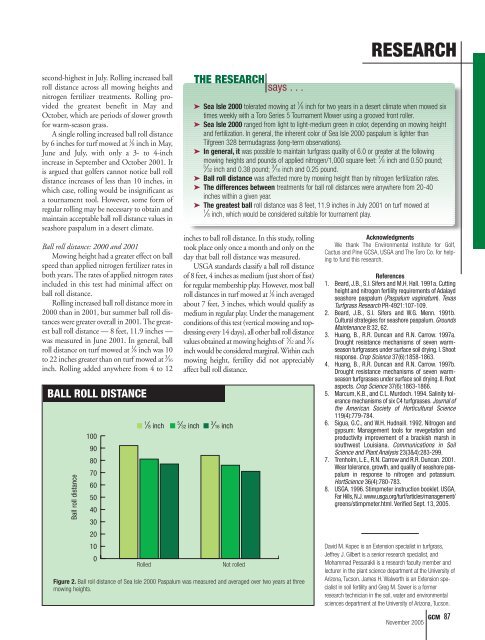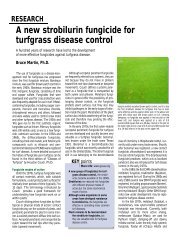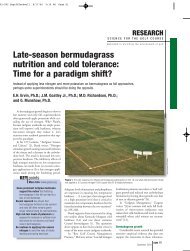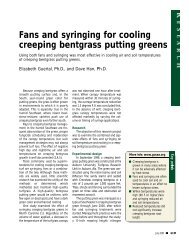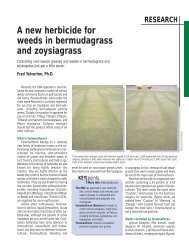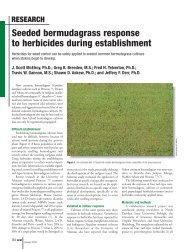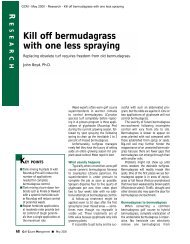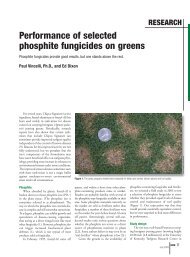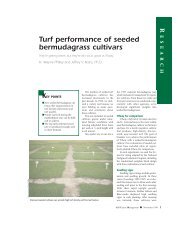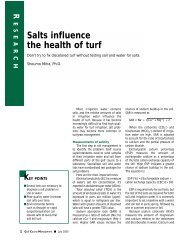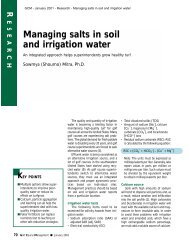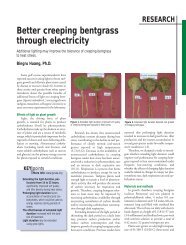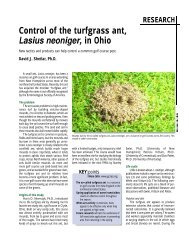Sea Isle 2000 on desert greens: Mowing height and ... - GCSAA
Sea Isle 2000 on desert greens: Mowing height and ... - GCSAA
Sea Isle 2000 on desert greens: Mowing height and ... - GCSAA
You also want an ePaper? Increase the reach of your titles
YUMPU automatically turns print PDFs into web optimized ePapers that Google loves.
sec<strong>on</strong>d-highest in July. Rolling increased ball<br />
roll distance across all mowing <strong>height</strong>s <strong>and</strong><br />
nitrogen fertilizer treatments. Rolling provided<br />
the greatest benefit in May <strong>and</strong><br />
October, which are periods of slower growth<br />
for warm-seas<strong>on</strong> grass.<br />
A single rolling increased ball roll distance<br />
by 6 inches for turf mowed at 1 ⁄8 inch in May,<br />
June <strong>and</strong> July, with <strong>on</strong>ly a 3- to 4-inch<br />
increase in September <strong>and</strong> October 2001. It<br />
is argued that golfers cannot notice ball roll<br />
distance increases of less than 10 inches, in<br />
which case, rolling would be insignificant as<br />
a tournament tool. However, some form of<br />
regular rolling may be necessary to obtain <strong>and</strong><br />
maintain acceptable ball roll distance values in<br />
seashore paspalum in a <strong>desert</strong> climate.<br />
Ball roll distance: <str<strong>on</strong>g>2000</str<strong>on</strong>g> <strong>and</strong> 2001<br />
<strong>Mowing</strong> <strong>height</strong> had a greater effect <strong>on</strong> ball<br />
speed than applied nitrogen fertilizer rates in<br />
both years. The rates of applied nitrogen rates<br />
included in this test had minimal affect <strong>on</strong><br />
ball roll distance.<br />
Rolling increased ball roll distance more in<br />
<str<strong>on</strong>g>2000</str<strong>on</strong>g> than in 2001, but summer ball roll distances<br />
were greater overall in 2001. The greatest<br />
ball roll distance — 8 feet, 11.9 inches —<br />
was measured in June 2001. In general, ball<br />
roll distance <strong>on</strong> turf mowed at 1 ⁄8 inch was 10<br />
to 22 inches greater than <strong>on</strong> turf mowed at 3 ⁄16<br />
inch. Rolling added anywhere from 4 to 12<br />
BALL ROLL DISTANCE<br />
Ball roll distance<br />
100<br />
90<br />
80<br />
70<br />
60<br />
50<br />
40<br />
30<br />
20<br />
10<br />
0<br />
THE RESEARCH says . . .<br />
Figure 2. Ball roll distance of <str<strong>on</strong>g>Sea</str<strong>on</strong>g> <str<strong>on</strong>g>Isle</str<strong>on</strong>g> <str<strong>on</strong>g>2000</str<strong>on</strong>g> Paspalum was measured <strong>and</strong> averaged over two years at three<br />
mowing <strong>height</strong>s.<br />
RESEARCH<br />
➤ <str<strong>on</strong>g>Sea</str<strong>on</strong>g> <str<strong>on</strong>g>Isle</str<strong>on</strong>g> <str<strong>on</strong>g>2000</str<strong>on</strong>g> tolerated mowing at 1 ⁄8 inch for two years in a <strong>desert</strong> climate when mowed six<br />
times weekly with a Toro Series 5 Tournament Mower using a grooved fr<strong>on</strong>t roller.<br />
➤ <str<strong>on</strong>g>Sea</str<strong>on</strong>g> <str<strong>on</strong>g>Isle</str<strong>on</strong>g> <str<strong>on</strong>g>2000</str<strong>on</strong>g> ranged from light to light-medium green in color, depending <strong>on</strong> mowing <strong>height</strong><br />
<strong>and</strong> fertilizati<strong>on</strong>. In general, the inherent color of <str<strong>on</strong>g>Sea</str<strong>on</strong>g> <str<strong>on</strong>g>Isle</str<strong>on</strong>g> <str<strong>on</strong>g>2000</str<strong>on</strong>g> paspalum is lighter than<br />
Tifgreen 328 bermudagrass (l<strong>on</strong>g-term observati<strong>on</strong>s).<br />
➤ In general, it was possible to maintain turfgrass quality of 6.0 or greater at the following<br />
mowing <strong>height</strong>s <strong>and</strong> pounds of applied nitrogen/1,000 square feet: 1 ⁄8 inch <strong>and</strong> 0.50 pound;<br />
5<br />
⁄32 inch <strong>and</strong> 0.38 pound; 3 ⁄16 inch <strong>and</strong> 0.25 pound.<br />
➤ Ball roll distance was affected more by mowing <strong>height</strong> than by nitrogen fertilizati<strong>on</strong> rates.<br />
➤ The differences between treatments for ball roll distances were anywhere from 20-40<br />
inches within a given year.<br />
➤ The greatest ball roll distance was 8 feet, 11.9 inches in July 2001 <strong>on</strong> turf mowed at<br />
1<br />
⁄8 inch, which would be c<strong>on</strong>sidered suitable for tournament play.<br />
inches to ball roll distance. In this study, rolling<br />
took place <strong>on</strong>ly <strong>on</strong>ce a m<strong>on</strong>th <strong>and</strong> <strong>on</strong>ly <strong>on</strong> the<br />
day that ball roll distance was measured.<br />
USGA st<strong>and</strong>ards classify a ball roll distance<br />
of 8 feet, 4 inches as medium (just short of fast)<br />
for regular membership play. However, most ball<br />
roll distances in turf mowed at 1 ⁄8 inch averaged<br />
about 7 feet, 3 inches, which would qualify as<br />
medium in regular play. Under the management<br />
c<strong>on</strong>diti<strong>on</strong>s of this test (vertical mowing <strong>and</strong> topdressing<br />
every 14 days), all other ball roll distance<br />
values obtained at mowing <strong>height</strong>s of 5 ⁄32 <strong>and</strong> 3 ⁄16<br />
inch would be c<strong>on</strong>sidered marginal. Within each<br />
mowing <strong>height</strong>, fertility did not appreciably<br />
affect ball roll distance.<br />
■ 1 ⁄8 inch ■ 5 ⁄32 inch ■ 3 ⁄16 inch<br />
Rolled<br />
Not rolled<br />
Acknowledgments<br />
We thank The Envir<strong>on</strong>mental Institute for Golf,<br />
Cactus <strong>and</strong> Pine GCSA, USGA <strong>and</strong> The Toro Co. for helping<br />
to fund this research.<br />
References<br />
1. Beard, J.B., S.I. Sifers <strong>and</strong> M.H. Hall. 1991a. Cutting<br />
<strong>height</strong> <strong>and</strong> nitrogen fertility requirements of Adalayd<br />
seashore paspalum (Paspalum vaginatum). Texas<br />
Turfgrass Research PR-4921:107-109.<br />
2. Beard, J.B., S.I. Sifers <strong>and</strong> W.G. Menn. 1991b.<br />
Cultural strategies for seashore paspalum. Grounds<br />
Maintenance 8:32, 62.<br />
3. Huang, B., R.R. Duncan <strong>and</strong> R.N. Carrow. 1997a.<br />
Drought resistance mechanisms of seven warmseas<strong>on</strong><br />
turfgrasses under surface soil drying. I. Shoot<br />
resp<strong>on</strong>se. Crop Science 37(6):1858-1863.<br />
4. Huang, B., R.R. Duncan <strong>and</strong> R.N. Carrow. 1997b.<br />
Drought resistance mechanisms of seven warmseas<strong>on</strong><br />
turfgrasses under surface soil drying. II. Root<br />
aspects. Crop Science 37(6):1863-1866.<br />
5. Marcum, K.B., <strong>and</strong> C.L. Murdoch. 1994. Salinity tolerance<br />
mechanisms of six C4 turfgrasses. Journal of<br />
the American Society of Horticultural Science<br />
119(4):779-784.<br />
6. Sigua, G.C., <strong>and</strong> W.H. Hudnaill. 1992. Nitrogen <strong>and</strong><br />
gypsum: Management tools for revegetati<strong>on</strong> <strong>and</strong><br />
productivity improvement of a brackish marsh in<br />
southwest Louisiana. Communicati<strong>on</strong>s in Soil<br />
Science <strong>and</strong> Plant Analysis 23(3&4):283-299.<br />
7. Trenholm, L.E., R.N. Carrow <strong>and</strong> R.R. Duncan. 2001.<br />
Wear tolerance, growth, <strong>and</strong> quality of seashore paspalum<br />
in resp<strong>on</strong>se to nitrogen <strong>and</strong> potassium.<br />
HortScience 36(4):780-783.<br />
8. USGA. 1996. Stimpmeter instructi<strong>on</strong> booklet. USGA,<br />
Far Hills, N.J. www.usga.org/turf/articles/management/<br />
<strong>greens</strong>/stimpmeter.html. Verified Sept. 13, 2005.<br />
David M. Kopec is an Extensi<strong>on</strong> specialist in turfgrass,<br />
Jeffrey J. Gilbert is a senior research specialist, <strong>and</strong><br />
Mohammad Pessarakli is a research faculty member <strong>and</strong><br />
lecturer in the plant science department at the University of<br />
Ariz<strong>on</strong>a, Tucs<strong>on</strong>. James H. Walworth is an Extensi<strong>on</strong> specialist<br />
in soil fertility <strong>and</strong> Greg M. Sower is a former<br />
research technician in the soil, water <strong>and</strong> envir<strong>on</strong>mental<br />
sciences department at the University of Ariz<strong>on</strong>a, Tucs<strong>on</strong>.<br />
November 2005<br />
GCM 87


